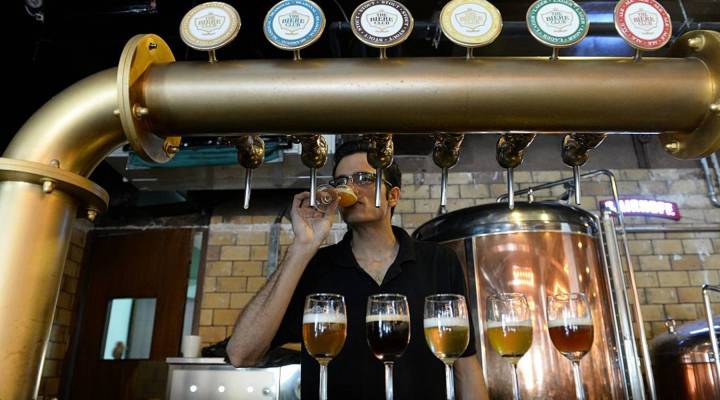
The craft beer industry may be a model for us all

The craft beer industry is facing a lot of long odds: Consumers are drinking less beer. The largest producers in the industry, Anheuser-Busch and MillerCoors, are selling fewer brews. Yet the industry is going through a bit of a boom, at least for small businesses like your local microbrewery. And the answer may have to do with the unique way that the beer industry is regulated.
Derek Thompson, the senior editor at The Atlantic, wrote about the craft beer industry’s growth. Thompson spoke to Marketplace host Kai Ryssdal about his reporting. The following is an edited transcript of their conversation.
Kai Ryssdal: So beer consumption overall is down. Some of the biggies are selling less, yet craft beer is not only staying afloat, it is doing well. How is that happening?
Derek Thompson: It’s doing fantastically well. I was sort of rooting around in government data and realized that something really weird happened in the last decade between 2008 and 2016. The number of brewery establishments expanded by a factor of six. It sextupled. And the number of brewery workers grew by more than 100 percent. It more than doubled. So what we’re looking at is the craft beer revolution, which anyone who’s frequented a bar sometime in the last five or 10 years clearly understands, is so huge that it’s having an enormous effect at the sort of government-data level in terms of employment and establishments. And it’s a really sort of interesting story, because you have this extraordinary growth in employment despite the fact that this is a 200-year-old industry. So it’s rare for something like that to happen.
Ryssdal: Exactly. It is perhaps the definition of a mature industry. What is going on here?
Thompson: So there’s a lot of things that seem to be going on. Beer has a very specific regulatory regime, a very specific regime that essentially separates producers from middlemen from retailers, or so-called three-tier system, that is designed to explicitly make it difficult for vertical monopolies to occur. That is, for a company to own the production and distribution and retailing of a product. And so in an industry like this, where the regulatory regime makes it hard for one company to own everything, it makes it more likely for something like the craft beer revolution to happen, for a thousand flowers to bloom at the at the local level. And that’s precisely what we’re seeing.
Ryssdal: And so what we’re talking about here is these local tap houses where I can go in and get a growler of whatever my favorite locally produced brew is, right? That’s the distribution channel that we’re talking about here.
Thompson: It is. And what’s interesting about tap rooms you just mentioned is that tap rooms actually allow really small brewers to sell their beer directly. The regulatory environment is such that they’ve made it difficult for the big guys to sell directly, while allowing exceptions at the state level for, you know, Kai’s IPA or Derek’s sour, to open a tap room and serve people who come right by. So that allows our, you know, our fledgling little beers to develop a local fandom and then grow a little bit. And then once you reach a certain level, then it becomes illegal for us to sort of bypass this three-tier system.
Ryssdal: Brief side note known here, we actually bandied about the idea of developing a Marketplace Kai-P-A. That’s a true story. Never went anywhere.
Thompson: Kai-P-A, oh man, that sounds delicious.
Ryssdal: I mean c’mon on. It’s almost too easy. Let me throw a word at you here, though, and get your reaction. Bearing in mind that not too long ago, we were hearing tales of, you know, tripling of hop prices and hops being off the market, hop being the key ingredient in some of those good new craft beers. The word I want to run by you here is bubble.
Thompson: Well, on the one hand I’ve talked to a lot of people who know the craft beer industry a lot better than I do, and they do think that we are nearing the peak of this craft beer bubble. So if you are looking to get into that market, Mr. Kai-P-A, definitely do it now rather than wait for the bubble to burst and start your business on the other side of it. That said, 2016 was probably the best year in American history for employment at breweries. And 2017 appears to be right about on track to match it. So it really looks like things are still accelerating, or at least were through the first half of 2017.
There’s a lot happening in the world. Through it all, Marketplace is here for you.
You rely on Marketplace to break down the world’s events and tell you how it affects you in a fact-based, approachable way. We rely on your financial support to keep making that possible.
Your donation today powers the independent journalism that you rely on. For just $5/month, you can help sustain Marketplace so we can keep reporting on the things that matter to you.












